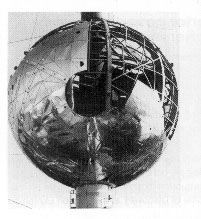|
There were three conditions to the choice of the solution:
1. The possibility of fixing the skin elements on the
spheres at great height.
2. The covering had to be rain-proof.
3. The exterior aspect had to conform with what the
Atomium was supposed to represent.
There were very few similar constructions from which
experience could be drawn for the covering of the Atomium.
The construction to which it could best be compared
was the Dome of Discovery at the London Exhibition
in 1951.
The experience provided by the English engineers
gave us two starting points for the choice of our solution:
riveting the sheets did not make the skin suffuciently
rainproof, and the connecting rod system had to be used,
the more so as the framework of the Atomium was of
steel, which meant taking into account the different
coefficients of expansion of the aluminium skin and the
framework of the sphere.
Spherical triangles, the three sides of which are great
circles of the sphere, have the advantage of providing
uniform radiuses for all the elements.
 So as to arrive at an esthetical solution which would
be as close as possible to the symbol of the Atomium, I
tried to divide the surface of the sphere by great circles
into the greatest possible number of equal spherical
triangles. Using the junction of The tube center-lines with
the sphere as compulsory meeting points, I was led to
trace a network of 48 equal or symetric spherical triangles
formed by the intersections of nine great circles disposed
as shown in Fig. 2. These 48 great spherical triangles
are the basis of the system adopted. These had to
be further subdivided into spherical triangles to have the
necessary panels of sheeting for the nine spheres, bearing
in mind of course the cut-outs necessary for the tubes
and the penetration points of the bipods and their stairs.
So as to arrive at an esthetical solution which would
be as close as possible to the symbol of the Atomium, I
tried to divide the surface of the sphere by great circles
into the greatest possible number of equal spherical
triangles. Using the junction of The tube center-lines with
the sphere as compulsory meeting points, I was led to
trace a network of 48 equal or symetric spherical triangles
formed by the intersections of nine great circles disposed
as shown in Fig. 2. These 48 great spherical triangles
are the basis of the system adopted. These had to
be further subdivided into spherical triangles to have the
necessary panels of sheeting for the nine spheres, bearing
in mind of course the cut-outs necessary for the tubes
and the penetration points of the bipods and their stairs.

An added point was that it was to be possible at night,
to light up the Atomium by circulating luminous spots
along the 9 great circles of each sphere. With these
points for a start, the Enghien St. Eloi Co. Ltd built a
system of aluminium panels out of 12/10 mm thick sheet,
the edges of which are mounted on a special welded aluminium
frame.
Each of the 48 great triangles is made up of 15 of
these small panels which are themselves spherical triangles.
The 9 great circles which separate the 48 great
triangles are 16-inch wide ribbon sheets, in rectangular
sections.
All these panels are bolted together from inside and
their intersection made rainproof by a plastic joint and a
second one in rubber.
The junction points at the summit of the triangles are
supported by circular plates which are attached to the
secondary framework by means of a connecting rod
made flexible by a sort of rubber Cardan.
The choice of disposition of the 15 secondary triangles
was conditioned by the fact that, in certain spheres
of the Atomium, large plexiglass windows had to be put
in place of the aluminium panels.
The aluminium of the spheres is a very special metal.
It is an alloy called "Peraluman 15" overlaid, by rolling,
with a thin sheet of aluminium called "reflectal", which
can be nearly specularly polished by a special process.
The exterior night-lighting is made by placing circular
light-points at regular intervals (about 5 ft) along the nine
great circles of each sphere. By means of rotary switch.
gear, the lamps come on and off successivly; this gives
the impression of luminous spots turning around the
spheres at a certain speed. These luminous spots meet
at the intersection of the great circles and thus gives the
spectator an impression of pulsating light at different
points of the sphere. The idea of this lighting is to represent
the rotation of the electrons around each atom of
the iron crystal.
| 